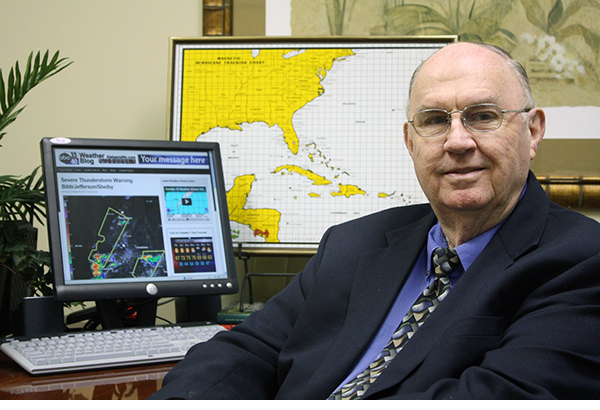Exhaustive Look At 4/3/74
PLEASE NOTE: Be sure and scroll down to the morning video discussion from James Spann. You will find a link to our hour-long Weather Brains that deals exclusively with the Super Outbreak of tornadoes on April 3-4, 1974. There is also a link to a video that we did in Guin later. Please shut your eyes while I am on the screen and just listen.
That super outbreak of tornadoes was by far the most memorable event in my 32-year career with the USWB/NWS. I happened to be on midnight to 8 shift that week at our office at 11 West Oxmoor Road. I had worked 11 hours getting off at 11:00 a.m. on the 3rd because of severe weather in the area. I went home and got about 4 hours sleep only to be awakened by a phone call from Jay Shelley to hurry back to the office. From that point I worked 17 consecutive hours without a break.
But this story is not about me. Everyone on duty went through a long drawn out ordeal that we can never forget. So, for the rest of the story, I am going to use we instead of I.
NATIONAL OVERVIEW
Most of this story will deal with our experience here in Alabama, but here are some basic facts of the big picture. Even today you might read slight variations in the numbers. By every measure, this outbreak of tornadoes outranked everything so far, including severity, longevity and extent. Tornadoes touched down all the way from North Alabama and North Georgia northward to Tennessee, Kentucky, Indiana, Ohio, Illinois, West Virginia and even one over the border in Canada. These scary national numbers:
….148 tornadoes
….95 rated F2 or stronger
….30 F4 or F5 (those caused the most destruction and deaths)
….fatalities in 11 states
….48 killer tornadoes
….335 fatalities
….6,000 plus injuries
….some tornadoes on the ground for as much as 90 miles and even 100 miles
….If you add all the path lengths together, it would mean 2,598 miles had a tornado on the ground.
….10 states later declared disaster areas
….At one point in the heat of battle, 15 tornadoes were on the ground at the same time.
….Xenia, Ohio is written in history.
….Brandenburg, Kentucky hard hit. Tornado moved across a new car dealership, numerous new cars became airborne and were dumped in the Ohio River.
THE ALABAMA STORY
….We had some severe weather as early as April 1.
….Our big event was later in the day and the night of April 3.
….A Tornado Warning was issued for Jefferson County at 3:55 in the afternoon. Tornado Watches were already in effect. That was just the beginning of an unbelievable night.
….Alabama suffered the most of the 13 states affected by the outbreak with 86 deaths and 949 injuries. I believe the total deaths were finally scaled back to the 70s, because there was a temporary mixup when some South Tennessee fatalities were included.
….4 of the Alabama tornadoes were extremely intense and stayed on the ground a long time.
….Allen Pearson at the time was Director of the National Severe Storms Forecast Center in Kansas City. (That office is now known as the Storm Prediction Center based in Norman, Oklahoma.) Bob Ferry was the Meterologist in Charge at the time at our National Weather Service Forecast Office, 11 West Oxmoor Road, Birmingham. He and Allen Pearson were very good friends. Pearson called Mr. Ferry on April 2 and warned that if the WSR-57 radar at Centreville needed maintenance or fine tuning, it should be rushed to completion immediately. He also added, “If you thougt Monday night was bad, just wait until Wednesday.”
On the morning of April 3, the Kansas City unit issued a brilliant severe thunderstorm outlook covering a huge area from North Louisiana over to South Carolina and into Michigan.
NOW THE MAIN ALABAMA STORY:
On April 1, there was a rash of severe weather from Pickens, Tuscaloosa, Jefferson and Cullman Counties eastward to St. Clair, Blount, Etowah and Calhoun Counties. Numerous reports of hail, funnels and high wind. At 9 o’clock that night, a tornado caused severe damage in the Sheerwood and Research Park sections of West and NW Huntsville, including a number of homes severely damaged. A fatality and 5 additional injuries off Pulaski Pike north of Huntsville all in mobile homes. There were several other tornadoes, but let’s jump forward to the main event on April 3.
APRIL 3, 1974 IN ALABAMA
In terms of monetary damage, Alabama, by far, experienced the most costly tornado disaster on record in the late afternoon and evening of April 3, 1974. It was at least three times more costly than the outbreak of May 27, 1973 when severe damage occurred at Greensboro, Brent, Wilsonville, Center Point and other locations.
Before the April 3 event was over late at night and into the early morning hours of April 4, 77 persons were killed and 938 injured. The fatalities and injuries by counties:
23 deaths Marion County, 250 injuries (mostly Guin)
14 deaths Madison County, 220 injuries
16 deaths Limestone County, 121 injuries
16 deaths Lawrence County, 63 injuries
5 deaths Winston County, 22 injuries
56 injuries Morgan County
4 injuries Franklin County
2 deaths Fayette County, 29 injuries
1 death Cullman County, 36 injuries
102 injuries Walker County, mostly Jasper area
5 injuries Pickens County
6 injuries Tuscaloosa County
20 injuries Cherokee County
4 injuries Jackson County
There were 10 confirmed tornadoes including five powerful ones with long paths. In addition, two smaller tornadoes occurred the next afternoon (April 4) in SE Alabama. All of the major tornadoes occurred over the northern part of the state and all of the fatalities and injuries. These numbers for Alabama only:
….370 miles total path length (all tornado paths added together)
….1075 dwellings totally destroyed
….776 dwellings major damage
….1072 additional dwellings with lesser damage
….408 mobile homes destroyed
….135 additional mobile homes major damage
….723 farm buildings destroyed
….299 farm buildings major damage
….205 small businesses destroyed or severely damaged
This story will be far too long if we describe every tornado but we look at the main ones. (The show began with a tornado on the ground west of Birmingham in the Concord area. Not major. Now the big ones:
….F4 tornado began 9 miles NNW of Aliceville at 5:35 pm and moved NE. Continuous damage began in NW Tuscaloosa County 3 miles west of Moore’s Bridge. It became stronger south of Berry in Fayette County and two persons were killed in a church near the Walker County line. The church was destroyed. The tornado moved through the heart of Jasper causing severe damage with about 100 injuries. This happened about one hour before Guin, in Marion County, would get almost wiped off the map by a separate top-of-the line F5. Back in Jasper, the Walker County Courthouse. There is a blessing in a way. It struck at night with the building empty. If it had been during the day, undoubtedly the death/injury total would be very high. On a storm survey, we stepped into the edge of the courthouse and there was severe interior damage, timbers stuck in walls, shreds of glass, you name it. The Walker County tornado continued NE crossing the east part of Smith Lake, briefly becoming a waterspout. Then it moved through the South and SE part of the City of Cullman. Several shopping centers were damaged and numerous houses heavily damaged or demolished in SE Cullman where there was 1 fatality and 36 injuries.
Late in the afternoon, a powerful F5 touched down in West Lawrence County about 10 miles WSW of Moulton. The giant moved rapidly NE taking everything in its path. At that very moment, I was racing back to our office and I heard the warning on WVOK radio. The NWS/Huntsville had said it was taking everything in its path. I was accustomed to hearing numerous tornado warnings or writing them, but that one really grabbed my attention. The giant tornado passed 3 miles NW of Moulton where 14 people were killed in rapid succession, mostly in the Mariah community. Six members of one family died when they became airborne and blown into the woods. After passing along the north side of Jackson Mountain, it moved on to the flat terrain west of Decatur and approached the Tennessee River. A chemical plant was extensively damaged on the south bank. It then entered the Tennessee River moving across two-mile wide Wheeler Lake. It turned into a giant water spout. It emerged on the north shore. Practically every tree over a 3/4-mile wide swath were flattened leaving a pattern of a giant swirl. The storm was so powerful that reddish topsoil was dug out and plastered against the fallen trees giving them a reddish-brown color. The tornado funnel also turned reddish brown.
MORE LATER: I am sorry to cut this off without the full story, but time is of essence. There is much more to tell and I will finish that later today or tonight in a separate post. I must say that I am indeed thankful to the late Carroll Eddings, owner of WFMH in Cullman. The station got knocked off the air when the earlier tornado moved across Cullman. He was always a great help to us. He grabbed a microphone and raced out to his transmitter, hooked the microphone up using emergency power and we continued to broadcast a lot of live updates form our weather office on his station.
Category: Uncategorized















